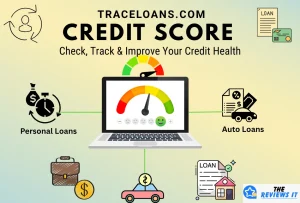In today’s financial world, your credit score plays a major role in loan approvals, interest rates, and even rental decisions. Traceloans.com credit score services make it easier than ever to check, monitor, and improve your credit health—all in one place.
Whether you’re building credit from scratch or trying to fix past mistakes, Traceloans.com provides accurate, real-time insights and tools to help you take control of your financial future.
What You’ll Get On Traceloans.com?
Traceloans.com offers a range of tools, tips, and expert insights to help you manage your credit score and understand different loan options easily.
1. Detailed Loan Breakdowns
Traceloans.com credit score helps users understand different loan options by clearly explaining their benefits, risks, eligibility rules, and interest rate patterns.
2. Market-Driven Insights
Through ongoing research and expert analysis, the website offers updates on shifts in the lending landscape, helping users stay informed and prepared.
3. Step-by-Step Financial Guidance
From picking the right type of loan to managing repayments smartly, Traceloans walks you through every stage with practical, beginner-friendly advice.

Categories On Traceloans.com credit score
- Personal Loans
- Mortgage Loans
- Auto Loans
- Student Loans
- Bad Credit Loans
- Business Loans
1. Personal Loans
A personal loan is a sum of money borrowed from financial institutions that you can use for various purposes, such as credit card debt, financing home renovations, or covering significant life events like weddings.
These loans can be obtained from banks, credit unions, or online lenders and must be repaid over time, typically with interest. Some lenders may also charge additional fees.
- 1. Secured Personal Loans
These loans require you to put up collateral, like a car or savings account. Because there’s less risk for the lender, interest rates are often lower. - 2. Unsecured Personal Loans
The most common type, unsecured loans, don’t require any collateral. Approval depends on your credit score and financial history.
Whether you choose a secured or unsecured loan usually depends on your credit profile and how much risk the lender is willing to take.
Loan Application Eligibility Checklist
Before approving a personal loan, lenders look at a few key things to decide if you’re a trustworthy borrower. These include your credit score, monthly income, debt-to-income ratio, and in some cases, collateral.
Generally, having a higher credit score and a lower debt burden makes it easier to qualify and get better interest rates. But even if your credit score isn’t perfect, you may still be eligible, though you might face higher interest rates or need a co-signer.
Lenders also pay close attention to whether your income is stable and consistent, as this directly shows your ability to repay the loan on time.
How Personal Loans Work?
Personal loans are a flexible way to borrow money, whether you’re paying off existing debt, handling unexpected expenses, or funding a major purchase. To get the most out of a personal loan, it’s important to understand the steps involved, from applying to repayment.
Application Process
Getting started with a personal loan usually begins by checking if you qualify. Many lenders allow you to pre-qualify online by entering basic information like your income and credit profile.
This quick step doesn’t affect your credit score and gives you an idea of your potential loan terms. If you decide to move forward, you’ll fill out a formal application and provide more detailed documents, such as proof of income, employment, and identification.
At this point, the lender will run a hard credit check, which may slightly lower your credit score for a short time. Some online lenders offer same-day approval and quick fund transfers, making the process fast and convenient.
Approval Criteria
Lenders look at several factors before approving a loan. These often include:
- Credit score – Higher scores can help secure better interest rates.
- Income – Lenders want to see stable, sufficient income to ensure you can make repayments.
- Debt-to-income ratio (DTI) – This shows how much of your income is already committed to other debts.
- Collateral – For secured personal loans, you may need to offer an asset like a car or savings.
A strong credit profile and low DTI can improve your chances of approval and help you get lower interest rates.
2. Mortgage Loan
A mortgage is a loan used to buy real estate, where the property itself serves as collateral. It allows buyers to spread payments over several years—usually 15 to 30—making homeownership more affordable.
If the borrower fails to repay, the lender can foreclose and take the property. Monthly payments include principal, interest, and often taxes or insurance.
Types Of Mortgage
Mortgages come in different types to match your financial goals and repayment plans.
- Fixed-Rate Mortgage
The interest rate stays the same for the entire loan term—usually 15, 20, or 30 years. Payments are predictable and ideal for long-term stability. - Adjustable-Rate Mortgage (ARM)
Starts with a low fixed rate for a few years, and then the rate adjusts periodically based on market conditions. It may become more expensive over time.
Mortgage Process
The mortgage process involves several key steps, from pre-approval to closing the deal on your new home.
1. Pre-Approval
The journey starts with mortgage pre-approval, where the lender evaluates your credit score, income, and financial history to determine how much you can borrow. This gives you a clear budget and shows sellers you’re a serious, qualified buyer, often giving you an edge in a competitive market.
2. Home Appraisal
Once you’ve selected a property, the lender will arrange for a professional home appraisal. This step ensures the property’s value matches the loan amount. The appraiser reviews factors like location, size, condition, and recent sales of similar homes. A fair appraisal protects both you and the lender from overpaying.
3. Loan Approval
Next, your loan enters the underwriting phase, where the lender takes a closer look at your financial details and the property appraisal. They confirm everything checks out before giving final approval. If you’re applying for an adjustable-rate mortgage (ARM), it’s especially important to understand how future payments may change.
4. Closing
The final step is closing, where you sign all the legal paperwork and finalize the transaction. You’ll review the loan terms, pay closing costs (usually 2–5% of the loan amount), and officially become the property owner. This process typically takes a few weeks, with an average closing timeline of around 43 days.
3. Auto Loans
An auto loan is a type of financing that helps you purchase a vehicle—new or used—by borrowing money from a lender, which you then repay over time with interest. The car itself typically serves as collateral, meaning the lender can repossess it.
If you fail to make payments. Auto loans come with fixed or variable interest rates and vary in terms depending on the lender and your credit profile.
Where To Apply?
You can apply for an auto loan through banks, credit unions, online lenders, or directly at dealerships. Credit unions often offer lower rates, while online lenders provide quick comparisons. Dealership financing is convenient but may have higher rates. Compare multiple offers to get the best terms.
What Do You Need To Apply For An Auto Loan?
To apply for an auto loan, you’ll typically need the following documents:
- Valid driver’s license – for identity verification.
- Social Security number – to check your credit history.
- Proof of income – such as recent pay stubs, tax returns, or bank statements.
- Proof of residence – like a utility bill or lease agreement.
- Vehicle details – if applicable, include trade-in title and registration.
Having these documents ready can speed up the process and improve the approval chances.
Auto Loan Terms
Interest Rate (APR): Based on your credit score, loan amount, and lender. Better credit often means a lower rate.
Loan Duration Matters: Auto loan terms usually range from 12 to 96 months, with common options being 36, 48, 60, and 72 months. A shorter term means higher monthly payments but less interest overall.
A longer term lowers the monthly cost but increases total interest, and can lead to negative equity if your car loses value faster than you repay the loan.
How It Affects Monthly Payments: Extending your loan term can make payments more manageable, but it also means paying more in interest. For instance, stretching a $20,000 loan from 36 to 60 months at 9% interest could cost you an extra $2,000.
Always weigh the lower monthly payment against the true cost over time.
4. Student Loans
Traceloans.com Student Loans is a type of financial aid specifically designed to help students pay for college or higher education expenses, including tuition, books, housing, and other costs.
These loans can come from the federal government or private lenders and must be repaid with interest after graduation or once a student leaves school.
Unlike scholarships or grants, student loans are borrowed funds, so understanding repayment terms and options is crucial for long-term financial health.
Types Of Student Loans
Student loans come in various forms, each with different terms, interest rates, and benefits.
How To Apply For Student Loans?
To apply for a student loan, start by filling out the FAFSA (Free Application for Federal Student Aid) at fafsa.gov. This form helps determine your eligibility for federal loans, grants, and work-study programs.
You’ll need to provide details about your (and your family’s) income and assets. Once submitted, the schools you applied to will send you financial aid offers outlining how much loan, grant, or aid you’re eligible for.
Carefully review the offers—compare interest rates, repayment terms, and fees—before accepting the best option for your situation.
6. Business Loans
A business loan is a type of financing provided to entrepreneurs or companies to support business needs, like expanding operations, buying equipment, or managing day-to-day expenses.
These loans come in various forms (term loans, lines of credit, SBA loans, etc.) and are offered by banks, credit unions, or online lenders. Business loans are repaid over time, usually with interest, and often require a solid business plan, good credit, and proof of steady income to qualify.
Types Of Bad Credit Loans
Here are some common types of bad credit loans you can explore, each with different risks and requirements:
- Personal Loans for Bad Credit
- Secured Loans for Bad Credit
- Payday Loans (Not Recommended)
- Title Loans (Not Recommended)
Tip: Always compare loan terms, fees, and lender reputation before choosing any of these options, especially if your credit is already in poor shape.
Alternatives To Bad Credit Loans
If you have poor credit and want to avoid high-interest loans, consider these safer and more flexible alternatives:
- Credit Builder Loans
Offered by some banks and credit unions, these small loans help you build a positive payment history and improve your credit score over time. - Peer-to-Peer (P2P) Lending
Online platforms connect you directly with individual investors who may offer better rates than traditional lenders. - Credit Unions
Often more flexible than banks, credit unions may provide small loans with reasonable terms to members, even with less-than-perfect credit. - Friends or Family
If you have a trusted relationship, borrowing from someone you know can help avoid fees and high interest—just be sure to set clear terms in writing.
6. Business Loans
A business loan is a type of financing provided to entrepreneurs or companies to support business needs, like expanding operations, buying equipment, or managing day-to-day expenses.
These loans come in various forms (term loans, lines of credit, SBA loans, etc.) and are offered by banks, credit unions, or online lenders. Business loans are repaid over time, usually with interest, and often require a solid business plan, good credit, and proof of steady income to qualify.
Types Of Business Loans
Businesses have access to several types of loans depending on their goals, cash flow, and credit standing. So create GoMyFinance.com Budget to control money, also here are some of the most common options:
- Term Loans
These are traditional loans where businesses receive a lump sum upfront and repay it over a fixed period with interest. Term loans are ideal for large expenses like expansion, inventory, or equipment. - SBA Loans
Backed by the U.S. Small Business Administration, SBA loans offer low interest rates and long repayment terms. They’re great for startups or small businesses needing working capital, equipment, or real estate funding. - Business Lines of Credit
A line of credit offers flexible funding—borrow only what you need, when you need it. You only pay interest on the amount used, making it useful for managing short-term cash flow. - Equipment Financing
This loan type helps businesses purchase machinery or tech. The equipment itself usually acts as collateral, which may help secure better rates or terms. - Invoice Financing
Also known as accounts receivable financing, this option lets businesses borrow money based on unpaid invoices—helping cover expenses while waiting on customer payments.
Each loan type comes with different eligibility requirements, interest rates, and repayment structures. Choosing the right one depends on your business’s needs, financial health, and long-term goals.
How To Apply For A Business Loan?
Securing a business loan starts with preparation. To boost your chances of approval, it’s important to follow these steps:
- Prepare Your Business Plan
Lenders want to see your vision and strategy. A clear business plan that outlines your goals, target market, and growth potential shows you’re serious and organized. - Gather Key Documents
Make sure you have updated business licenses, bank statements, income reports, tax returns (personal and business), and legal documents like your incorporation certificate or operating agreement. - Know Your Numbers
Be ready to present your company’s financial health, including profit margins, cash flow, and debt obligations. This helps lenders assess your repayment ability. - Compare Lenders
Don’t apply blindly. Use platforms like TraceLoans.com credit score to compare offers from banks, credit unions, and online lenders. Look at interest rates, terms, and fees. - Submit Your Application
Once everything’s ready, apply with your selected lender. Some may offer pre-approval or faster processing if you apply online.
By staying organized and informed, you can increase your chances of securing funding to grow your business confidently.
Become an Authorized User to Boost Credit Faster
If you’re new to credit or want to improve your score quickly, becoming an authorized user on someone else’s credit card can help. For example, if a family member has a good credit card they’ve had for years, and they add you to it, you may get the benefit of their payment history on your credit report.
Just make sure the person always pays on time and keeps their balance low. This can build your credit age and score, even if you don’t use the card yourself.
Please Read Before Using Traceloans.com
The information on this website is for general guidance only and not financial or legal advice. We try to keep content accurate and updated but can’t guarantee it fits every personal situation.
Always consult a professional before making financial decisions. This site may link to external websites we don’t control or endorse. Loan rules may vary by location. For trusted info in the U.S., visit the CFPB or FTC.
Conclusion
Whether you’re applying for a personal loan, buying your first home, financing a car, managing student debt, rebuilding your credit, or growing your business, Traceloans.com credit score provides the clarity, tools, and insights you need to make smarter financial decisions.
With its easy-to-navigate guidance, real-time credit monitoring, and detailed breakdowns across loan types, the platform empowers users at every stage of their financial journey.
It’s your one-stop resource for building confidence and improving outcomes, no matter your current situation. For more information, visit: traceloans.com
In a world where your traceloans.com credit score impacts nearly everything, having a trusted, transparent guide like traceloans.com credit score isn’t just helpful—it’s essential.
FAQs
What is Traceloans.com credit score?
Traceloans.com is a website that helps you understand loans and check your credit score easily. It offers tips, tools, and guides to improve your credit and make smart financial choices.
Can I check my credit score on Traceloans.com credit score?
Yes! You can check your credit score on Traceloans.com and track it over time to see how it changes.
Does Traceloans.com help if I have bad credit?
Absolutely. The site explains your options clearly and shows you ways to rebuild your credit, even if your score is low.
Is Traceloans.com credit score only for personal loans?
No, it covers many loan types—like mortgages, student loans, auto loans, and business loans—so you can choose what fits your needs best.
Is it free to use Traceloans.com?
Most of the guides and credit tools are free to use. You can explore the website without paying anything.









